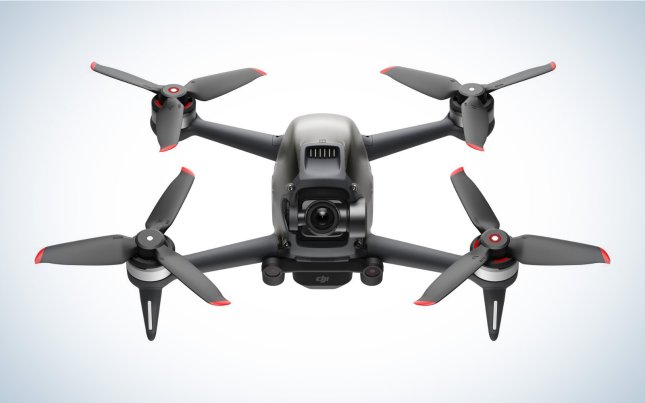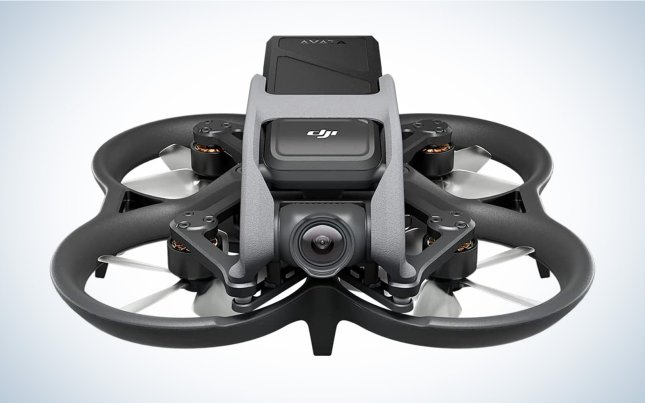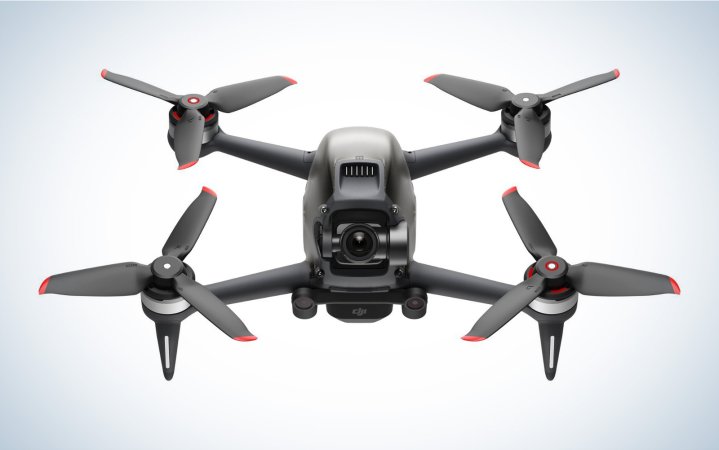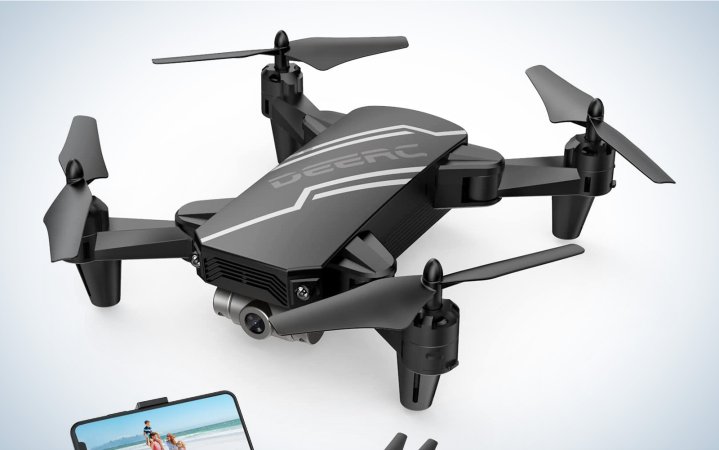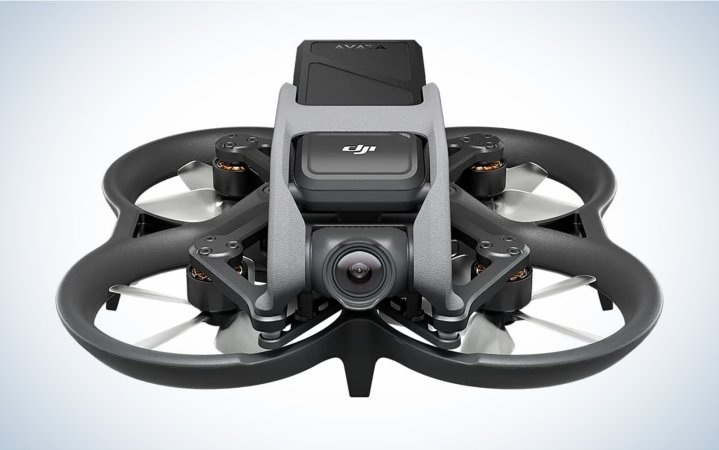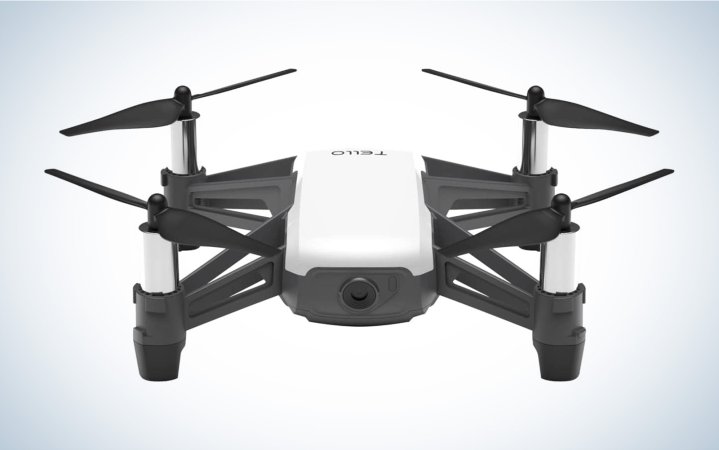We may earn revenue from the products available on this page and participate in affiliate programs. Learn more ›
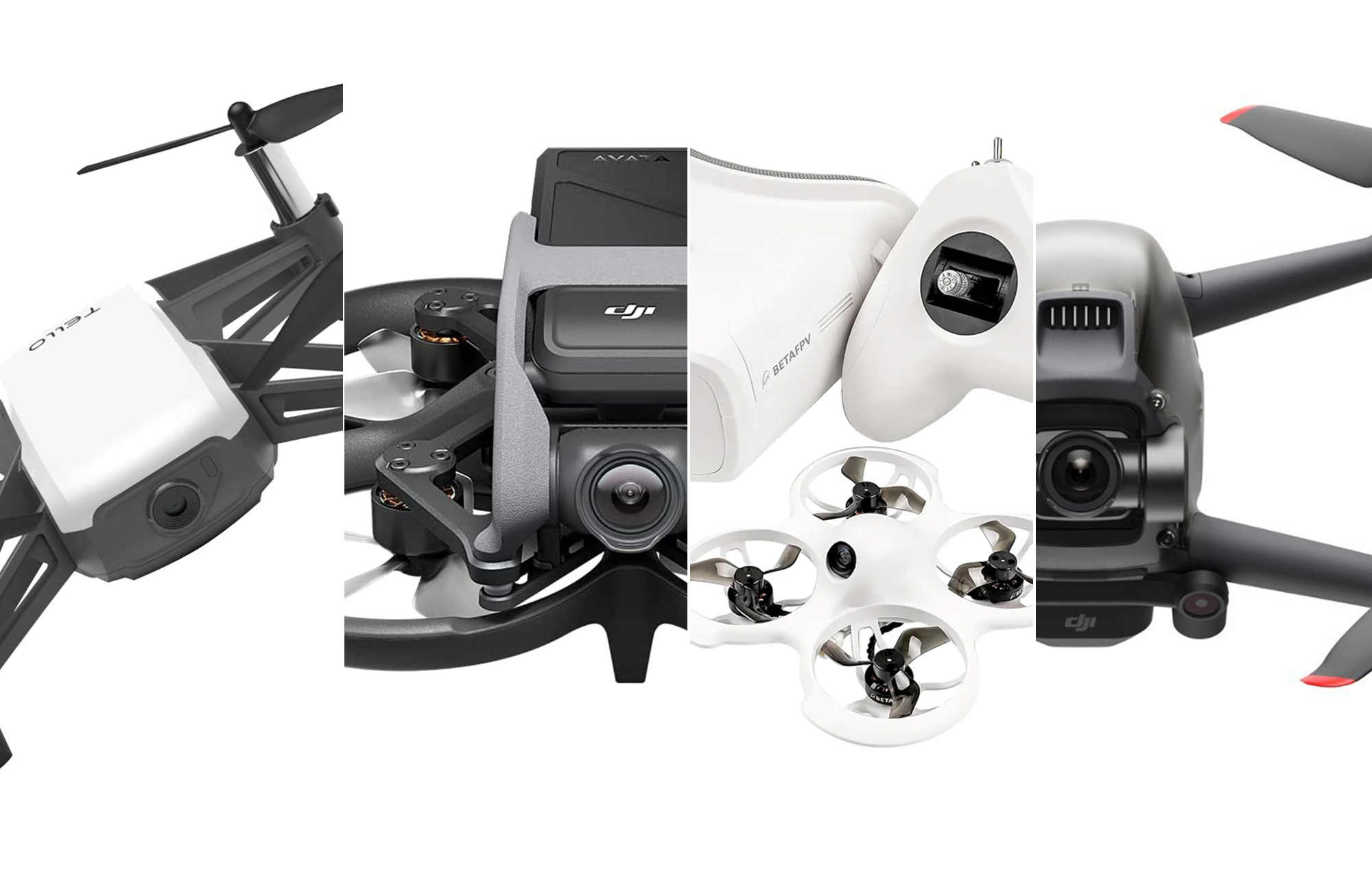
If you’ve seen incredible aerobatic video footage lately, there’s a good chance it was created with an FPV drone. Short for “first-person view,” FPV drones stream a live video feed back to a pilot’s headset, so it looks like they’re actually in a tiny cockpit. This view offers unprecedented control and enables high-performance feats like drone racing or truly harrowing video capture. In doing so, these FPV drones allow you to experience the world around you in ways you may never have thought possible, except perhaps in a video game. While the drone world has grown significantly in recent years, we’ve narrowed down this list of the best FPV drones to get you airborne with minimal fuss.
- Best overall: DJI FPV combo
- Best for beginners: BetaFPV Cetus Pro
- Best for kids: DEERC D20 Mini Drone for Kids
- Best for video: DJI Avata
- Best budget: Ryze Tello
How we chose the best FPV drone
Although one of the key brands in the drone market has been DJI, which is also true of FPV drones as well, we just didn’t limit our search to DJI FPV drones. We studied models from other brands as well. One characteristic we looked for from all models was if the drone was easy to use. We also tried to select models that were relatively durable. However, for some, like those racing FPV drones, there might not be many models that can last a long time in that environment. But by and large, we looked for models that could survive a few crashes. Another factor in selecting the models was considering the drone’s overall design, including its structural design and ergonomics and how it operated with its mobile app and other accessories.
The best FPV drones: Reviews & Recommendations
Drones have a rather large price range. Some more toy-like FPV drones can cost less than $100, while others can cost well over $1,000. That means you’ll want to find out not only how much money you want to spend but also what features are important to you and how you intend to be using the FPV drone.
Best overall: DJI FPV combo
DJI FPV drone
Pros
- Fast: Can fly as fast as 87 mph
- Fun, easy to use, and versatile
- Shoots good quality video and photos
- Nice selection of safety features
Cons
- For the price, battery life could be better
- Not as durably constructed as some other models
Why it made the cut: Its mix of advanced features and ease of use make it the best pick for those who don’t mind spending some money upfront.
Specs
- Dimensions: 12.2 x 10 x 5 inches
- Weight: 1.8 lbs.
- Video Recording Modes: 1080p resolution at 120/fps; 4K resolution at 60/fps
- Camera Resolution: 12 megapixels
- Maximum Flying Time: 20 minutes
The first thing some drone races look for when buying a racing drone is its top speed. And this model clearly stands out among FPV drones as it can fly as fast as 87 mph. But the DJI FPV stands out in other ways, too. For instance, take the price: This new kit from DJI provides everything you need to start flying in truly FPV fashion: In addition to the drone, you also get the DJI FPV goggles V2 (which are comfortable to wear and use), a remote control and the new motion controller, and more. That offers you a lot of value for the money. In addition, it can fly in three different flight modes, depending on your skill level, and also comes with a number of useful safety features, including the emergency “brake and hover” mode. Simply press a button on the controller. The drone will stop and hover stably within a few seconds.
The imaging and video specs are also quite good: You can shoot video with 4K resolution (at 60 fps) or 1080 resolution (at 120 fps, which can be useful for slow-motion video) at a very wide 150° field of view. You can also shoot 12-megapixel resolution photos. Plus, the done system includes collision technology to prevent it from crashing. Overall, this DJI combo kit provides a powerful immersive experience.
Best for beginners: BetaFPV Cetus Pro
BetaFPV Cetus Pro
Pros
- A great FPV drone to learn on
- Easy to use
- It has a sturdy design yet is lightweight
- Comes with clever features to keep you flying
Cons
- The included VR02 FPV goggles do not support video record function.
Why it made the cut: This is a great model to learn the basics of flying an FPV drone.
Specs
- Dimensions: 4.6 x 4.6 x 1.3 inches
- Weight: 0.1 lbs.
- Video Recording Modes: N/A
- Camera Resolution: N/A
- Maximum Flying Time: 4-5 minutes
Although this model is meant for beginners, it includes all the necessary elements for learning how to use an FPV drone: The Cetus Pro FPV kit includes the brushless quadcopter and a LiteRadio2 SE transmitter and VR02 FPV goggles. It’s lightweight but sturdy, and it also has an emergency battery and low-battery feature to avoid crashing the drone. Plus, there’s an altitude hold function, which lets that drone auto-hover. It even has a “turtle mode.” If the FPV drone has fallen to the ground and is now upside down, you can activate the “turtle mode” via the LiteRadio2 SE transmitter, and it will flip the Cetus Pro FPV back over to allow you to resume flying. Comes with three flight modes and flies at three different speeds.
One downside is that included VR02 FPV goggles do not support video record function. However, if you want to pay more, you can buy the VR03 FPV goggles, which do support video record function. Both the resolution for VR02 and VR03 FPV goggles are 480p.
Best for kids: DEERC D20 Mini Drone for Kids
DEERC D20 Mini Drone for Kids
Pros
- Very inexpensive
- Includes gesture control and voice commands
Cons
- Low-resolution video and photos
- Doesn’t connect with a pair of goggles
Why it made the cut: A very inexpensive and fun FPV drone.
Specs
- Dimensions: 7 x 4.7 x 1.7 inches
- Weight: 0.1 lbs.
- Video Recording Modes: 720p
- Camera Resolution: 1 megapixel
- Maximum Flying Time: 10 minutes
If you’re looking for an inexpensive drone for an older child or teenager, consider this model. This mini drone comes with some useful features to help kids learn how to fly drones: It can auto-hover with its altitude hold system, and it’s easy to use with its one-key start/stop function. It also comes with 3-speed modes.
However, some of the imaging features aren’t incredibly robust. Nevertheless, your kids might find them fun to play with. For instance, the onboard camera (which connects wirelessly to your smartphone and is where you see the streaming video) has only 720p HD video resolution. The photos are only 1280 x 720 resolution images, which is barely a 1-megapixel photo. But what is fun is that you can take photos and video clips via gesture control—if you make a victory or “V” sign with your fingers, the drone will capture a photo or video. It also has voice control: You can say “take off” or “landing” and the drone will respond accordingly.
Best for video: DJI Avata
DJI Avata
Pros
- Sturdy, compact construction
- A larger sensor and more megapixels for better quality video and photos
- Includes image stabilization
- Nice selection of safety features
Cons
- Can’t fly as fast as the DJI FPV
Why it made the cut: When you’re looking for a FPV drone that will take better quality videos and photos
Specs
- Dimensions: 7.1 x 7.1 x 3.1 inches
- Weight: 0.9 lbs.
- Video Recording Modes: 2.7K resolution at 120/fps; 4K resolution at 60/fps
- Camera Resolution: 48 megapixels
- Maximum Flying Time: 18 minutes
An important question you’ll need to answer before you buy an FPV drone is what are you buying a drone for? If it’s to buy the fastest consumer FPV drone, then you’ll want to buy the DJI FPV drone. The Avata’s top speed is 60 mph, which is fast but not quite as fast as the DJI FPV, which can fly up to 87 mph. But if you’re looking to buy a drone that shoots much better video quality as well as photo quality, then the DJI Avata is the model you’ll want to consider: The Avata comes with a large, 48-megapixel 1/1.7-inch sensor, which is one of the reasons you get better quality photos and video. The lens has an f/2.8 aperture and shoots with a wide 155-degree field of view. The Avata also captures 4K video at up to 60fps or 2.7k video at up to 120fps if you want slow-motion video.
Best budget: Ryze Tello
Ryze Tello
Pros
- Very inexpensive
- Easy to use
- Compatible with VR headsets
- Uses hand gestures
Cons
- Controller costs extra
- Imaging resolution is a bit on the low side
Why it made the cut: For an easy-to-use, inexpensive FPV drone that’s less than $100
Specs
- Dimensions: 3.7 x 3.7 x 1.6 inches
- Weight: 0.2 lbs.
- Video Recording Modes: 720p resolution video
- Camera Resolution: 5 megapixels
- Maximum Flying Time: 13 minutes
For those on a budget, this model might fit the bill. It’s powered with technology by DJI, so it’s still pretty full-featured for such a low-priced drone. However, it doesn’t come with a controller, which is one reason it’s so inexpensive. But you can connect it to your phone using the mobile app or a supported Bluetooth remote controller (connected to the mobile app). It’s also compatible with VR headsets. Also, if you’re interested in learning how to code, or if you’d like to have your kids learn how to code, this drone can be programmed using Scratch–MIT’s coding system for kids to learn on. However, it would be nice if it had slightly high video and still photo resolution.
Things to consider when shopping for the best FPV drones
There are many features to consider when buying an FPV drone. But you may find it helpful to start by asking yourself some questions: Are you experienced in flying drones or FPV drones? Are you buying this drone for a beginner or a teenager? Will you use them for racing, or are you more interested in shooting video or photos?
Controls
One key area to consider when comparing drones is figuring out how easy it is to use the controls and the drone system. Some work by connecting to your smartphone, while others come with dedicated controllers. Do some research to see which one might be the best for you. If you’re doing serious flying, a dedicated controller is an absolute must. Higher-end models allow for controller customization to fit your specific flight style.
Camera
There are also big differences in how they record and capture video or photos. Some, like the BetaFPV Cetus Pro FPV drone, are meant for you to learn how to fly these drones. In other words, it doesn’t include the capability of recording video or capturing photos, since it was designed for beginners to learn on. But other pricier models give you the ability to capture 4K resolution video and 48mm still photos. Some custom models allow for swappable camera systems so that you can attach your own GoPro or another action camera to it.
FAQs
According to the Federal Aviation Administration’s website, “All drones must be registered, except those that weigh 0.55 pounds or less (less than 250 grams) and are flown exclusively under the Exception for Recreational Flyers.” The fee for registering is $5 and is valid for three years. For more on registering your drone, go to the FAA website.
The maximum allowable altitude is 400 feet above the ground, higher if your drone remains within 400 feet of a structure (according to the FAA).
The maximum speed is 100 mph (87 knots) (according to the FAA).
You can fly during daylight or in twilight (30 minutes before official sunrise to 30 minutes after official sunset, local time) with appropriate anti-collision lighting.
Final thoughts when buying the best FPV drones
- Best overall: DJI FPV combo
- Best for beginners: BetaFPV Cetus Pro
- Best for kids: DEERC D20 Mini Drone for Kids
- Best for video: DJI Avata
- Best budget: Ryze Tello
Have you ever wondered if you could get motion sickness, which could make you feel lightheaded or even nauseous, from using goggles with an FPV drone? The answer to this question is “Yes!” The effect is similar to what you might experience when watching a VR experience through a VR headset. One of the theories about this sickness is that it’s a fairly common side effect caused by the brain’s struggle to square what you see with what you feel—your brain might think you’re flying like Superman over a building. Still, you’re just standing in the middle of your living room. If you experience motion sickness when using an FPV drone, consider taking a break from using the goggles for 15 or 20 minutes before you try using them again.
